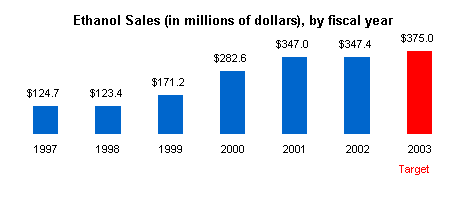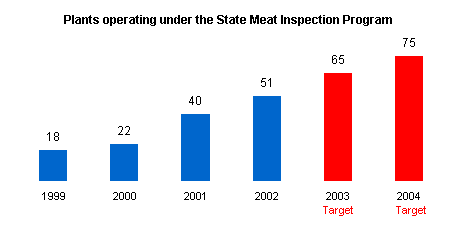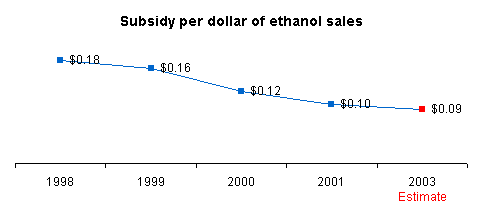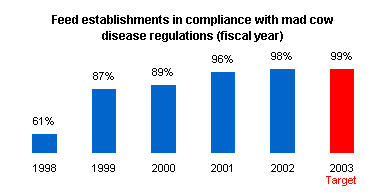
|
AGRICULTURE: COMPETITIVE ANYWHERE IN THE WORLD We are in a global economy whether we like it or not. As such, we can either bemoan those factors (i.e., prices) over which we have no control - or we can work together to make our farm families the most competitive we can by lowering the cost of production or adding value to the raw products before they leave the state. With this in mind we need to give attention to taxation policy, overly burdensome environmental regulations and land-use laws, access to capital, financing and organizational structuring options, and adequate transportation infrastructure. We also must support research and technology transfer, as well as encourage continuing educational opportunities. We need to work to "level the playing field" in both international trade and national farm policies so that our farmers and agri-businesses can compete in a fair, competitive arena. In addition, we need to improve and increase marketing opportunities, both domestic and foreign, not only for our major commodities, but also for unique and specialty crops and products. Farm families that utilize risk management techniques will have increased their potential to succeed - we must help them develop these skills. Minnesota is in the worldwide spotlight. We need to take advantage of this opportunity. Our farms and agri-businesses are some of the most productive anywhere. Our goal is to help them create new opportunities and showcase them throughout the world. Lead Departments: Agriculture
|
|||||
The Big Accounting Initiative
Score Increase the level of Minnesota's agricultural exports. Increase Minnesota's cash receipts from livestock and crop products. Increase annual net farm income per farm in Minnesota. Increase annual sales of agricultural-based renewable fuels. Increase annual sales of Identity Preserved and Minnesota Certified products. Fiscal year compliance with mad cow disease regulations (BSE Rule, 21 CFR 589.200) |
|||||

|
|||||
|
Why is the indicator
important? Since Minnesota
farmers produce far more than our citizens can consume, our farmers’
fate is tied to their ability to sell their goods to people outside
America’s borders. Each year, Minnesota exports a third of its corn,
half of its soybeans, and a third of its wheat. What is MDA doing? Trade development missions are among the most effective tools the state uses to expand export opportunities. Over the years, Governor Ventura and MDA Commissioner Gene Hugoson have traveled to key developing markets such as Japan, Mexico and southeast Asia. Beyond these trade missions, the MDA’s Marketing Services Division conducts a number of activities to develop international markets for Minnesota agriculture products. The MDA regularly hosts trade delegations from foreign countries, showing off the state’s superb agricultural production and processing sectors. Marketing staff also have developed targeted programs promoting specific Minnesota products to specific foreign markets. Is MDA meeting the indicator target? Numbers for 2001 will be available in October 2002
Learn
more about:
To learn more about MDA’s trade
development missions, visit |
|||||
| top
|
|||||
Increase Minnesota's cash receipts from livestock and crop products. |
|||||
|
Why is
the indicator important?
Agriculture and its related industries employ one of every five
Minnesotans and our agriculture sector supports many other industries
such as construction, manufacturing, transportation and retail trade.
Crop and livestock production is the foundation of all this economic
activity. When farm-level production declines, there is a trickle-down
effect that threatens the rest of the economy. What is MDA doing? The reasons for declining farm production are varied, so the MDA has a wide variety of initiatives designed to boost that production. Some initiatives are designed to make Minnesota a more attractive place to farm. For example, the MDA has developed the Livestock-Friendly Counties program to encourage local communities to develop a more supportive environment for livestock production. Other MDA initiatives focus on helping farmers maximize profitability with their existing production. For example, the MDA offers a dairy diagnostic program that helps farmers boost their profitability by bringing in a team of industry experts to help review a farmer’s operation and suggest changes that may boost profitability. Is MDA meeting the indicator target? Numbers for 2001 will be available in October 2002
Learn
more about: For more on the Dairy diagnostic program, visit http://www.mda.state.mn.us/dairyfood/diagnostics.html |
|||||
| top
|
|||||
|
Why is this indicator important? Production agriculture jobs
serve as engines for Minnesota’s economy. Each on-farm agricultural
production job helps create an additional three jobs in all economic
sectors. In rural Minnesota, agriculture accounts for 30% of all
employment. Two-thirds of all agricultural jobs are off-farm, in
processing, distribution, supply and service sectors. For more information about farm income in Minnesota, visit: http://www.mgt.org/fbm/reports/index.htm |
|||||
| top
|
|||||
|
Why is the indicator important? Prices for many farm
commodities fluctuate greatly from month to month or even week to week.
It can be very difficult for farm families to set a budget for their
business and living expenses when their revenue from commodity sales can
vary so greatly over time. Given this fluctuation, it behooves farmers
to look for marketing tools that can remove some of the peaks and valley
from commodity prices. To do that, farmers have at their disposal an
expanding array of risk management tools, such as revenue insurance,
hybrid contracts, futures and options. As farmers’ use of these tools
increases, so can their financial security and peace of mind. For more information about MDA’s risk management programs for farmers, visit: http://www.mda.state.mn.us/riskmgmt/default.htm For more information about the DOPP program, visit: http://www.rma.usda.gov/training/programs/dopp/ |
|||||
| top
|
|||||
Increase annual sales of agricultural-based renewable fuels. |
|||||
 |
|||||
|
Why is this indicator important? Biofuels such
as ethanol and biodiesel make sense in Minnesota for several reasons.
First, they add value to major Minnesota crops such as corn and
soybeans, both of which are priced lower in Minnesota than in most other
states due to our distance from export markets. Second, the processing
of these Minnesota crops into biofuels creates new business
opportunities and jobs in greater Minnesota. Third, growing our own
fuels within the United States lessens our reliance on foreign energy.
Finally, the use of biofuels in Minnesota’s cars, trucks and other
vehicles can lead to cleaner air since these fuels burn cleaner than
traditional fuels. For more on ethanol,
visit: http://www.ethanol-gec.org/
|
|||||
| top
|
|||||
Increase annual sales of Identity Preserved and Minnesota Certified products. |
|||||
|
Why is the indicator important? Globalization
of agricultural marketplace is forcing a transition from the traditional
production to market oriented production. Identity preservation is an
important part of this transition. Identity Preserved (IP) crops are
traced back to their origin, segregated from similar products, and
not-co-mingled into a commodity flow at any point prior to delivery. |
|||||
| top
|
|||||
 |
|||||
|
Why is this indicator important? Farmers typically get less than 30 cents of every dollar an American consumer spends on food. To capture more of the consumer dollar, Minnesota farmers need tools that will help them expand their marketing options and improve food safety to maintain a high level of consumer confidence. What is the MDA doing? The MDA created the State Meat Inspection Program in 1998 to help develop and expand marketing opportunities for small meat processing establishments and for farmers who want to market top quality meat and poultry products directly to consumers. The MDA’s State Meat Inspection Program has performance targets for:
Is the MDA meeting the indicator target? Since the inception of the State Meat Inspection Program, the numbers of plants operating under this system has grown steadily, opening and expanding new markets for the plants and the farmers that supply them. In 2002, the MDA and the U of M provided training to the meat industry on Listeria monocytogenes, allergens and other food safety issues at the Minnesota Association of Meat Processors annual convention. The MDA will continue to develop training opportunities each year for this association. The MDA will also team up with the Food and Drug Administration (FDA) in 2002, to provide a seminar for egg producers and producer packers on egg safety relating to the reduction and prevention of Salmonella Enteritidis in shell eggs. The partnerships that the Meat Inspection program has developed with the FDA, United States Department of Agriculture, U of M, AURI and others has increased awareness of food safety issues and assisted the industry in producing safe meat and poultry products for Minnesota consumers and expanded the volume of meat and poultry products produced in the state each year. To learn more about:
|
|||||
| top
|
|||||
Fiscal year compliance with mad cow disease regulations (BSE Rule, 21 CFR 589.200) |
|||||
|
Why is this indicator important? In 1997, the Food and Drug Administration established regulations prohibiting the feeding of most mammalian proteins to cattle and other ruminant animals. This was done in response to evidence that suggested Bovine Spongiform Encephalopathy (BSE or Mad Cow Disease) might have developed in Great Britain as a result of the use of animal feed containing contaminated meat and bone meal as a protein source. What is the MDA doing? To ensure this federal rule is being followed locally, the MDA has contracted and partnered with the FDA in its enforcement efforts. The MDA has performance targets for:
Is the MDA meeting the indicator target? Based on the efforts of the MDA, the rate of compliance with the BSE rule has increased from nearly 61 percent during the program’s inception in fiscal year 1998 to 98 percent in fiscal year 2002. To learn
more: |
|||||
| top
|
|||||







